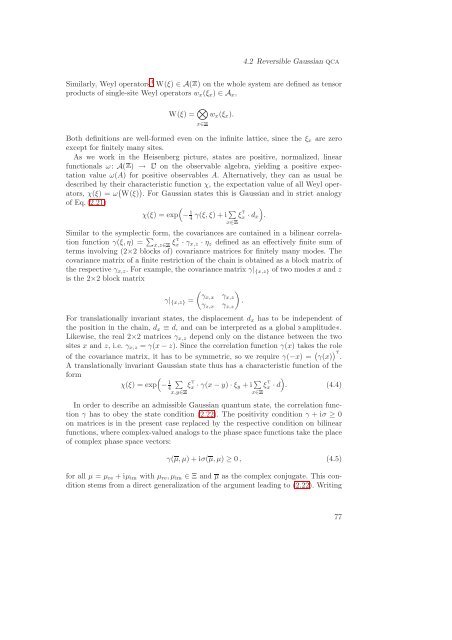Quantum Information Theory with Gaussian Systems
Quantum Information Theory with Gaussian Systems
Quantum Information Theory with Gaussian Systems
You also want an ePaper? Increase the reach of your titles
YUMPU automatically turns print PDFs into web optimized ePapers that Google loves.
4.2 Reversible <strong>Gaussian</strong> qca<br />
Similarly, Weyl operators 4 W(ξ) ∈ A() on the whole system are defined as tensor<br />
products of single-site Weyl operators wx(ξx) ∈ Ax,<br />
W(ξ) = <br />
x∈wx(ξx).<br />
Both definitions are well-formed even on the infinite lattice, since the ξx are zero<br />
except for finitely many sites.<br />
As we work in the Heisenberg picture, states are positive, normalized, linear<br />
functionals ω: A() →on the observable algebra, yielding a positive expectation<br />
value ω(A) for positive observables A. Alternatively, they can as usual be<br />
described by their characteristic function χ, the expectation value of all Weyl operators,<br />
χ(ξ) = ω W(ξ) . For <strong>Gaussian</strong> states this is <strong>Gaussian</strong> and in strict analogy<br />
of Eq.(2.21)<br />
<br />
χ(ξ) = exp −1 <br />
4 γ(ξ, ξ) + i<br />
x∈ξ T<br />
<br />
x · dx .<br />
Similar to the symplectic form, the covariances are contained in a bilinear correlation<br />
function γ(ξ, η) = <br />
x,z∈ξ T<br />
x · γx,z · ηz defined as an effectively finite sum of<br />
terms involving (2×2 blocks of) covariance matrices for finitely many modes. The<br />
covariance matrix of a finite restriction of the chain is obtained as a block matrix of<br />
the respective γx,z. For example, the covariance matrix γ| {x,z} of two modes x and z<br />
is the 2×2 block matrix<br />
γ| {x,z} =<br />
γx,x γx,z<br />
γz,x γz,z<br />
For translationally invariant states, the displacement dx has to be independent of<br />
the position in the chain, dx ≡ d, and can be interpreted as a globalamplitude.<br />
Likewise, the real 2×2 matrices γx,z depend only on the distance between the two<br />
sites x and z, i.e. γx,z = γ(x − z). Since the correlation function γ(x) takes the role<br />
of the covariance matrix, it has to be symmetric, so we require γ(−x) = γ(x) T<br />
.<br />
A translationally invariant <strong>Gaussian</strong> state thus has a characteristic function of the<br />
form<br />
<br />
χ(ξ) = exp −1 <br />
4<br />
x,y∈ξ T<br />
<br />
.<br />
x · γ(x − y) · ξy + i <br />
x∈ξ T<br />
x<br />
<br />
· d . (4.4)<br />
In order to describe an admissible <strong>Gaussian</strong> quantum state, the correlation function<br />
γ has to obey the state condition (2.22). The positivity condition γ + iσ ≥ 0<br />
on matrices is in the present case replaced by the respective condition on bilinear<br />
functions, where complex-valued analogs to the phase space functions take the place<br />
of complex phase space vectors:<br />
γ(µ, µ) + iσ(µ, µ) ≥ 0 , (4.5)<br />
for all µ = µre + iµim <strong>with</strong> µre, µim ∈ Ξ and µ as the complex conjugate. This condition<br />
stems from a direct generalization of the argument leading to (2.22). Writing<br />
77
















